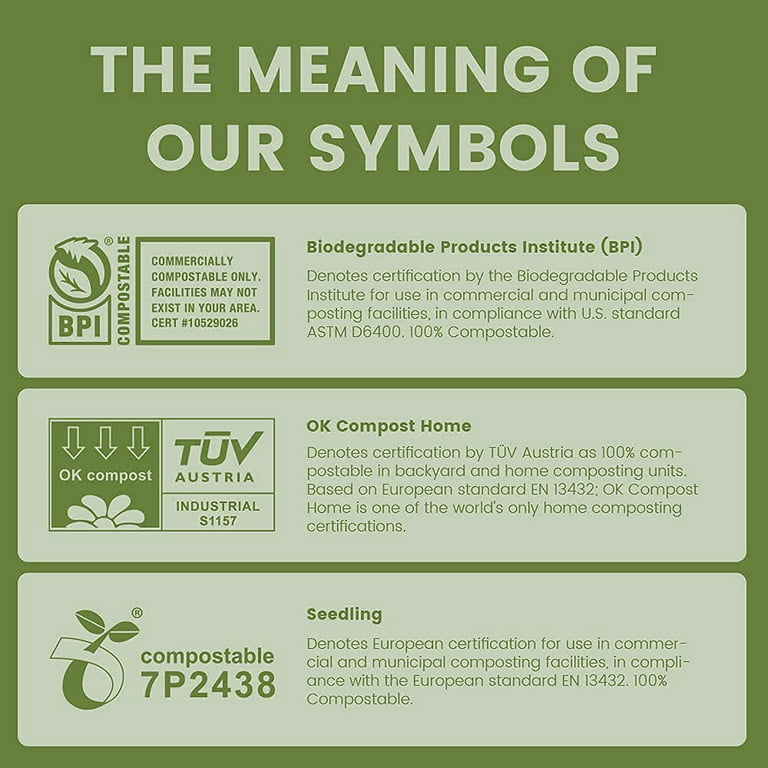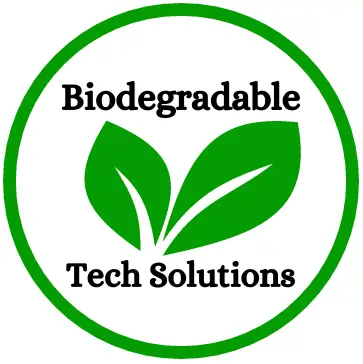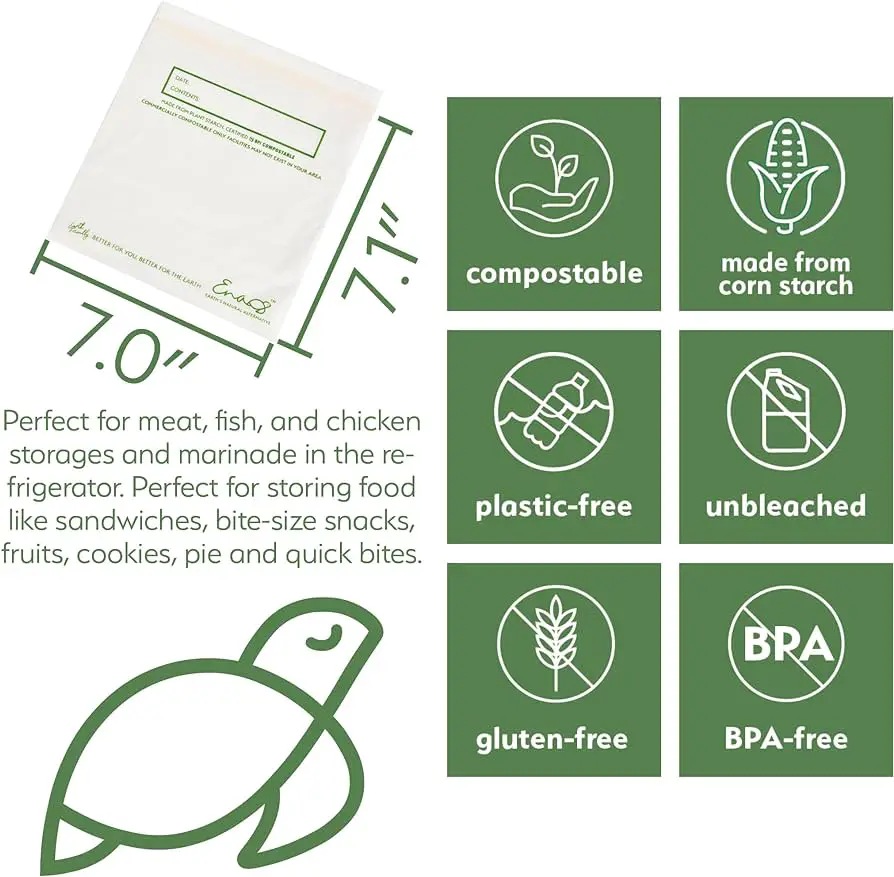Commercially compostable refers to materials that break down in commercial composting facilities. These products require specific conditions provided by such facilities to decompose properly.
With growing environmental awareness, the term “commercially compostable” is becoming increasingly relevant. It designates items typically crafted from plant-based, biodegradable materials which can return to the earth without leaving toxic residues. Recognizing this feature helps consumers and businesses make eco-friendly choices, supporting a sustainable closed-loop system.
Composting at an industrial level accelerates the decomposition process through controlled temperature, moisture, and aeration, which might not occur in a regular backyard compost heap. This terminology often appears on packaging and product descriptions, resonating with those who prioritize green practices. Understanding and distinguishing between home and commercially compostable materials is essential, as improper disposal can lead to contamination and waste management issues.
Unpacking Compostable Terminology
When we talk about eco-friendly products, the term ‘compostable’ often pops up. But what does it truly mean? Unraveling the mystery behind compostable materials shows the impact these products can have. Let’s dive into the world of composting, specifically what ‘commercially compostable’ signifies. We’ll break down complex terms into simple concepts to ensure you’re armed with the right eco-knowledge.
Defining ‘commercially Compostable’
Commercially compostable items are those that can break down in a commercial composting facility. Unlike backyard composting, these facilities manage waste at a larger scale. They ensure the right conditions for quick decomposition.
Products labeled as commercially compostable must meet certain standards. These products should:
- Break down into carbon dioxide, water, and biomass at a rate similar to paper.
- Disintegrate so that no large pieces remain visible in the compost.
- Leave no toxic residue behind that might harm the soil.
Certification organizations use tests to confirm a product’s compostability. Look for logos like BPI (Biodegradable Products Institute) or TÜV Austria OK Compost on packaging for assurance.
Contrasting Home And Commercial Composting
It’s essential to know the difference between home and commercial composting. Both processes decompose organic matter, but they do so differently.
| Home Composting | Commercial Composting |
|---|---|
|
|
Only put commercially compostable items in the green bin. They might not break down in a normal home compost.

Credit: byndgrn.com
The Science Behind Composting
Comprehending the science of composting reveals how organic waste transforms into nutrient-rich soil. This process plays a crucial role in waste management and environmental sustainability. Now, let’s delve into the science that makes this possible with two fundamental aspects: Biodegradation Processes and Factors Influencing Commercial Composting.
Biodegradation Processes
Biodegradation is nature’s way of recycling. It involves microorganisms such as bacteria and fungi. These organisms break down organic materials into simpler substances. This process occurs in several stages:
- Initial breakdown: Microbes consume easy-to-digest materials, releasing enzymes.
- Acidification: Organic acids form, facilitating further degradation.
- Maturity phase: Organic matter fully decomposes into humus.
Humus enriches the soil, providing essential nutrients for plant growth.
Factors Influencing Commercial Composting
Commercial composting requires precise conditions. Key factors include:
| Factor | Importance |
|---|---|
| Temperature | Speeds up degradation when optimal. |
| Moisture | Essential for microbial activity. |
| Oxygen | Facilitates aerobic digestion. |
| Organic Material | Provides “food” for microbes. |
Aeration, carbon-to-nitrogen ratio, and pH balance also affect the process significantly. In commercial settings, these factors are monitored and adjusted.
Only when the right conditions meet, materials break down efficiently. This produces high-quality compost suited for agricultural use. Properly maintained systems assure materials labeled as commercially compostable decompose within specified timeframes at such facilities.
Standards And Certifications
Understanding commercially compostable items is crucial. It implies the product breaks down in commercial composting facilities. They must meet certain standards and certifications. These ensure they decompose under specific conditions without leaving harmful residues.
Key Certifying Bodies
Certifying bodies assess products against compostability standards. They grant certifications if products meet the criteria.
- Biodegradable Products Institute (BPI): North America’s leading certifier for compostable products.
- TÜV Austria: Offers OK Compost HOME and OK Compost INDUSTRIAL certifications.
- DIN CERTCO: German-based certifier, providing the Seedling logo under European Bioplastics.
Interpreting Labels And Logos
Labels and logos communicate compostability to consumers.
| Logo | Signifies |
|---|---|
| Seedling | Compliant with European EN 13432 standard |
| BPI | Adherence to ASTM D6400 or D6868 in North America |
| OK Compost | Fit for industrial composting and sometimes home composting (OK Compost HOME logo) |
Look for these logos on packaging. They indicate if an item can go into the green bin. No logo? The product might not be compostable where you live.

Credit: www.walmart.com
Environmental Impacts
Commercially compostable materials break down into natural elements in a composting setting. This process turns waste into nutritious soil, cutting down on the need for chemical fertilizers. It means less waste in landfills reducing methane emissions, a potent greenhouse gas. By understanding its impacts, we can foster a greener future.
Benefits Of Commercial Composting
Commercial composting facilities turn organic waste into valuable compost. This sustainable practice offers numerous environmental advantages:
- Reduces landfill waste: Composting organic material prevents it from contributing to landfill growth.
- Lowers greenhouse gases: By composting, methane emissions from decomposing waste in landfills decrease.
- Conserves resources: Compost improves soil health, reducing the reliance on water, pesticides, and fertilizers.
- Encourages biodiversity: Healthy soil from compost supports wider varieties of plants and wildlife.
Common Misconceptions And Limitations
Despite its benefits, misconceptions and limitations about commercial composting exist:
| Misconception | Reality |
|---|---|
| All bioplastics are compostable | Only those labeled “compostable” break down in commercial facilities. |
| Compostable at home | Many items require the higher temperatures of commercial facilities to compost. |
| Instant process | Composting is a timely process that can take several months. |
Limited accessibility to facilities can hinder the composting potential. Certification standards for compostable products vary widely, adding to consumer confusion. It is essential to understand local composting capabilities to ensure proper waste management.
Commercial Composting Infrastructure
When we talk about Commercial Composting Infrastructure, we dive into a world where waste meets opportunity. This is where everyday items, designed to break down in commercial facilities, transform into nutrient-rich soil. The composting process is eco-friendly, turning what would be landfill fodder into a positive for the planet.
Availability And Accessibility
The heart of commercial composting lies in its availability and accessibility. A successful composting program depends heavily on how widespread and user-friendly facilities are. Here’s a glance at how this industry is growing:
- Expansion in major cities.
- Pick-up services for businesses.
- Drop-off spots increasing in neighborhoods.
Each area plays a crucial role in making the green process a part of our daily routine. Yet, it’s important to note that not all regions have these facilities. Locations and infrastructure can vary, posing challenges for businesses and consumers eager to participate.
Innovations And Challenges
As demand increases, the industry continues to innovate. New technologies and methods are in development to make composting faster and more efficient. While advancements are positive, there are hurdles to consider:
| Challenge | Innovation |
|---|---|
| High costs of operation | Energy-efficient machinery |
| Contamination from non-compostables | Improved sorting techniques |
| Limited public knowledge | Educational campaigns |
New machinery is being designed to lower costs and increase efficiency. Research is paving the way for better sorting to reduce contamination. Education campaigns aim to boost participation and understanding. The journey of commercial composting is evolving but faces both small and large challenges that need innovative solutions.

Credit: www.amazon.com
Consumer Responsibility And Action
Understanding ‘Consumer Responsibility and Action’ is key when it comes to commercially compostable products. Consumers have the power to shape the market and the environment. By making conscious choices and participating in appropriate disposal programs, consumers play a critical role in the lifecycle of compostable products.
Making Informed Purchases
Smart shopping habits lead to positive environmental impacts. Here’s how to make informed purchases:
- Look for certifications that confirm compostability.
- Research products and brands that align with green practices.
- Read labels carefully to distinguish between biodegradable and compostable. Participating in Commercial Composting Programs
- Identify local composting facilities that accept commercial compost.
- Compost at home or use community compost bins if available.
- Follow all guidelines for proper disposal to ensure items break down.
Participating In Commercial Composting Programs
Once you’ve brought compostable items into your home, next comes disposal. Here’s how to participate:
Remember, the right actions contribute to a cleaner, greener planet.
Frequently Asked Questions On What Does Commercially Compostable Mean
What Is Commercially Compostable?
Commercially compostable materials break down in a commercial composting facility. They transform into soil within a specific timeframe under controlled conditions. They must meet certain standards to be labelled commercially compostable.
How Does Commercially Compostable Differ From Biodegradable?
Commercially compostable goods must decompose in commercial facilities within a certain period. In contrast, biodegradable products break down naturally but at varying rates. Biodegradation lacks specific controlled environments or timeframes.
What Are The Requirements For Commercial Compostability?
To be considered commercially compostable, a product must meet specific ASTM D6400 or EN13432 standards. It should disintegrate within 90 days and biodegrade into carbon dioxide, water, and biomass within 180 days in a commercial facility.
Can Compostable Products Break Down At Home?
Some compostable products may not decompose in home composting setups due to lower temperatures. Commercial facilities provide the necessary heat, microbes, and turning to ensure proper breakdown.
Conclusion
Understanding commercial compostability is key to eco-conscious choices. Products that bear this label break down in specific conditions, aiding waste management efforts. As consumers, our purchasing power supports sustainable practices. Embracing commercially compostable items can significantly impact our planet’s health, steering towards a greener future.
Keep making informed decisions; our Earth deserves it.







